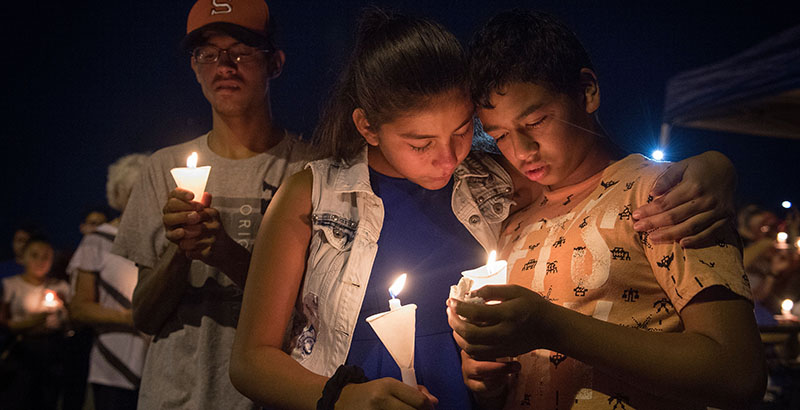Back to School but Nothing’s Normal. Schools Mobilize to Help Children of Immigrants After Traumatic Summer

It was a busy, if often frustrating, summer for the Trump administration’s many efforts to destabilize U.S. immigration policies. Federal judges ruled in August that, under a long-standing legal agreement, the administration was required to provide detained children at the border with “edible food, clean water, soap and toothpaste.” So the administration announced that it would write new regulations to supersede that agreement.
This came on the heels of the culmination of the administration’s multiyear push to redefine the country’s “public charge” rule, aiming to make it harder for hundreds of thousands of legal immigrants to obtain long-term legal residency in the United States. That effort also drew a raft of lawsuits.
For immigrant families and their communities, these recent efforts cap a terrifying few months. A series of dramatic ICE raids heightened immigrant communities’ fears across the country. And the Aug. 3 mass shooting in El Paso, Texas, was a horrific, dramatic escalation of a wave of violence targeting immigrants in recent years. Against this backdrop, rumors — that the administration might (illegally) start targeting undocumented children in public schools as a way of pressuring their families, for instance — come to resemble facts. Immigrants in the United States today often find the rule of law to be unreliable — and their place in the country to be insecure.
“We’re … at this culminating tipping point of the trauma and horror that this administration’s been inflicting upon kids and families on almost a weekly basis now,” said Wendy Cervantes, director of immigration and immigrant families at the Center for Law and Social Policy in Washington, D.C. “The cumulative effect has become particularly cumulative over the past summer. [It] feels like there’s something different about where we are right now.”
Making campus a refuge
The consequences of this onslaught are showing up in schools this fall. Around one-quarter of American children have at least one immigrant parent (and/or are immigrants themselves), and many of these children spent their summer facing significant stress and trauma.
“We’ve seen a huge increase in anxiety for our students,” says Jasmine Tarver, director of mental health and support services for the KIPP charter network’s Southern California schools. “[They’re] worried about their parents or someone in their community who might not be there when they get home … even if they don’t have anyone undocumented in their families. We’ve heard students talk about seeing the president on television say that he doesn’t care about them.”
As experts and educators explained at a congressional hearing on the topic last week, chronic stress can significantly impede a child’s learning at school. Last year, UCLA’s Civil Rights Project surveyed thousands of teachers and found that recent immigration policy instability was significantly disrupting students’ well-being and, correspondingly, their learning.
“When we think about early childhood development, what’s the number one thing that we think is critical to healthy development? Securely attached relationships. It’s this notion of dependability of ‘I’m going to cry and I trust you to be there to meet my needs,’” says Shantel Meek, founding director of the Children’s Equity Project at Arizona State University.
Recent, sudden changes to U.S. immigration policies risk, she explained, “taking away that trust, that security that kids have in their primary caregiver. We’re fundamentally messing with the social-emotional foundation of these kids … It’s like we’re intentionally causing trauma.”
ImmSchools, a nonprofit organization working to help schools better serve immigrant students and families, recently held a training for new Teach for America teachers working in New York City’s summer school classrooms. Vanessa Luna, ImmSchools’ co-founder, said students warned their teachers that their families would not attend summer school family engagement events due to fears around being targeted by immigration authorities.
How can schools respond? Since 2016, many school districts have passed “Safe Zone” and “Sanctuary” resolutions publicly clarifying what schools are to do in the event that immigration officials show up at their door. Resolutions differ slightly in language, but all seek to reassure families that their children are safe in schools and that information on immigration status will be neither collected nor distributed, in compliance with the Family Educational Rights and Privacy Act and the Supreme Court’s 1982 decision in Plyler v. Doe. Districts in California have led the way, with the California Department of Education encouraging local school leaders to adopt resolutions and providing structural support at the state level.
This summer’s instability prompted responses from other communities. Within the past few weeks, districts across the country, including Woodland Joint Unified School District (near Sacramento, California), Milwaukee Public Schools and Denver Public Schools, have reiterated support for their immigrant student populations. Other places followed suit, including the South Kingstown School District in Rhode Island. Noting the disruptive and traumatic effect of the Mississippi raids on nearby schools, South Kingstown adopted a resolution in support of a safe school environment for all students regardless of immigration status and is asking for the Rhode Island Department of Education to do the same.
Tarver says that KIPP’s Southern California schools also adopted a “Safe Schools” resolution promising to safeguard data they collect from immigrant families and to establish their campuses as havens from Immigration and Customs Enforcement raids. Her team of school counselors works with students directly impacted by ICE activity — and also with their Latinx peers living with anxieties about how secure they are in their communities and country. The schools also send alerts to all their contacts when they receive reports that ICE is operating in areas near the school and help connect detained families with legal counsel.
Schools and districts across the country are moving beyond protecting their campuses from immigration enforcement activity. Many are also focusing on how educators in their schools can actively work with children anxious from the attacks they’re witnessing against their communities. To do this work, some are finding it increasingly important to partner with local community organizations. In San Antonio and New York City, districts partner with ImmSchools to deliver training for educators. Their research-based trainings are tailored to the local community, with special attention paid to being responsive to feedback from those most affected.
“Every single educator that works in a primarily immigrant neighborhood should get training on this,” says Luna. “They should get training on trauma-informed practices. They should get training on what happens if there is a parent detained or deported. What are some of the key ways in which you can respond and how you can prepare? There should be training on cultural responsiveness and how you bring forward immigration in your curriculum in a way in which you’re building empathy towards all immigrants.”
To that end, in New York City, ImmSchools partners with UnLocal, a nonprofit focused on providing legal representation and community education to the undocumented community, and the Internationals Network for Public Schools, an organization helping start and support high schools serving newcomer students. Together, they deliver a comprehensive series of trainings that prepare educators to support students in the current climate. These touch on topics including the educational rights of undocumented students, how to create a supportive, trauma-informed and inclusive classroom for children of immigrants, and how schools can respond to raids.
Liliana Vargas, the Internationals Network’s senior director of programs, says that its schools are “getting ready, [with] practical approaches. They’re reviewing and updating family preparedness plans and emergency contact information. Before students even begin the learning process, they need to feel safe and secure … Our schools are very purposeful about the social, emotional and cultural aspects of community-building.”
Schools in the network also connect with social workers and mental health providers in their communities. They train all adults on staff — from teachers to people working in the front office — how to support children of immigrants.
Collective, whole-school approaches are necessary because the needs are pressing. Current immigration policies are affecting not just the well-being of undocumented and mixed-status families but also the well-being of the educators on the front lines. When left to address these needs on their own, teachers reported an increase in their levels of stress and anxiety; an increase in their workload and a shift in their responsibilities; and a deterioration in the sense of trust and community in schools, according to the UCLA Civil Rights Project’s 2018 survey.
Stop traumatizing kids in the first place
Of course, as millions of children of immigrants — mostly U.S. citizens themselves — returned to school this fall, it’s worth considering the limits of even the most comprehensive school approaches.
It’s cruel for the government to actively create stress and anxiety among children — and then leave historically underfunded schools to scramble for solutions. Instead of asking how educators can best respond to the growing anxiety in children of immigrants, the country could stop targeting their communities with inhumane and unpredictable shifts in American immigration policies.
To be sure, politically motivated targeting of immigrant families is a deep-rooted American tradition, but it’s disruptive to the nationwide efforts of many educators, schools and districts.
“It is OK to know and say that this is awful — but this is not normal,” says ImmSchools’ Luna. “You’re not supposed to feel this way. You’re not supposed to be afraid of being separated from your parents at your age. You are not supposed to. This is not normal.”
Disclosure: The 74’s CEO, Stephen Cockrell, served as director of external impact for the KIPP Foundation from 2015 to 2019. He played no part in the reporting or editing of this story.
Conor P. Williams is a fellow at The Century Foundation. Previously, Williams was the founding director of New America’s Dual Language Learners National Work Group. He began his career as a first-grade teacher in Brooklyn. He holds a Ph.D. in government from Georgetown University, a master’s in science for teachers from Pace University, and a B.A. in government and Spanish from Bowdoin College.
Rosario Quiroz Villarreal is a policy entrepreneur at the Next100, a pop-up think tank for the next generation of policy leaders. She is committed to increasing educational equity for immigrant students and students of color. A DACAmented bilingual educator in New York and Texas, Villarreal grew up navigating school as an undocumented student.
Get stories like these delivered straight to your inbox. Sign up for The 74 Newsletter

;)
